Sensory input provides information from the environment to facilitate evaluation and avoidance of danger, location and identification of essential resources, and social interaction, including reproduction and avoidance of conflict. As such sensory compromise not only affects the animal's ability to perform normal behaviour, but also has the potential to make the dog feel more vulnerable, and so anxious, at least during the initial period of adjustment. Owners may also find it distressing to see their pet struggling or unable to enjoy the things they used to. However, with appropriate support most dogs are able to adjust to sensory loss and maintain a good quality of life, in turn enabling owners to continue enjoying the companionship of their pet. As sensory compromise is most often diagnosed or treated at the veterinary surgery the practice team are best placed to advise owners how to achieve this. Although compromise of any sense is possible it is most common, and arguably most debilitating, in the optical and auditory systems.
The canine senses
To understand the effect of sensory loss it is first important to appreciate how dogs use their senses. A summary of the key characteristics of the canine senses of smell, hearing and sight is given in Table 1.
| Sense | Ability | Use |
|---|---|---|
| Smell | Olfactory ability varies with breed, but always vastly outstrips that of a human. The olfactory epithelial surface area in the dog ranges between 75–170 cm2, compared with 2–11.5 cm2 in humans, and contains 220 million to 2 billion olfactory neurons, compared with 12–40 million in humans (Miklosi, 2007; Beaver, 2009). The canine olfactory bulb has between 2.8 x 108 cells compared with 5–12 x 106 in humans (Beaver, 2009). Many breeds are also able to simply inhale much larger quantities of air than people. Canine behaviour patterns are designed to maximise scent collection and analysis. | Dogs use scent to identify and locate individuals of any species, determine gender and recognise another's mood or physiological state. They also use it for location and identification of places and objects of value, including prey. |
| Hearing | Dogs are able to hear a frequency range (pitch) of 20 Hz to at least 45 000 Hz, compared with humans that hear between 13–20 000 Hz. However they do not hear at greater intensity (loudness) than humans (Beaver, 2009). Dogs are better able to discriminate and localise sound due to the mobility of the pinna and advanced neural processing (Lindsay, 2000). | Dogs rely on vocalisations for location of others, alarm calling and communication including threat or conflict signals. They also evaluate environmental stimuli by sounds and have a heightened sensitivity to sounds that suggest danger. |
| Sight | Dogs have some binocular vision and a wider field of vision than humans, although this varies between breed according to the location of the eyes in the head. Rod and cone combinations are thought to offer about a quarter of the clarity enjoyed by humans, with certain breeds commonly being myopic. Dogs are able to discriminate blue and yellow alongside shades of grey, but see red or green in the blue/yellow spectrum. The tapetum maximises visual acuity in low lighting (Miller and Murphy, 1995). | Dogs rely less on vision than sound and smell, although this varies between breeds. For example sight hounds and some retrieving breeds are thought to have greater visual reliance. The dog's lack of visual acuity means they rely more on shape, movement and contrast between light and shade than detail. |
Supporting dogs with hearing loss
Safety
Loss of any sense reduces input of environmental information and so immediately places the dog at increased risk. Owners therefore need to be aware of dangers their dog will no longer notice and take steps to prevent accidents. For example deaf dogs will no longer be alerted to hazards usually identified by sound, such as traffic or household tools such as lawnmowers, and so need to be managed around them. Teaching the dog to regularly ‘check in’ for rewards enables the owner to guide their dogs in potentially hazardous situations both at home and in unfamiliar surroundings. This can also enable deaf dogs to run off lead, dependent on the reliability of their ‘check in’ as well as their recall.
Communication
Although dogs do use sound during communication they are not as reliant on human speech as owners often believe. Most owners typically use the spoken word to interact with and manage their dogs, and they do generally respond well to this. However this is due to an innate tendency to focus on and respond to humans (Miklosi et al, 2003), combined with learning to expect certain outcomes when they hear certain words, rather than a natural propensity to understand human language (Pilley, 2013). As such dogs are equally able to respond to natural cues or trained ‘commands’ that utilise other senses. For example a dog can learn that the visual cue of getting out a lead predicts a walk just as readily as the word ‘walkies’, and that putting their bottom on the floor when they see a flat hand raised has the same effect as doing so to the sound ‘sit’, i.e. it leads to being given a treat (or avoiding a correction where punitive methods are used). As such the cue chosen should depend on the individual dog's attributes, character and circumstances. Examples of those that can be used with deaf dogs are given at Table 2. See Figures 1–5.
| Signal | Use |
|---|---|
| Hand signals | Hand signals can use established human sign language or dog training cues or can be improvised by the owner as long as the signal is distinctive from everyday hand and body movements. Dogs that are not very observant may need obvious and expansive gestures whereas nervous dogs may respond better to subtler signals. Example hand signals can be seen in Figures 1–4. |
| Lights | Torches can be used in place of verbal signals or as a reward marker in place of a clicker, as long as the dog is attending to the handler. High-powered laser pointers are more visible when shined on a surface in daylight but care needs to be taken with use due to the risk of retinal damage. Outside lights can be used to cue a recall from the garden at night. |
| Touch | Touch can be used as a cue, particularly for an initial ‘look at me’ command with confident dogs. Worried dogs can be conditioned not to startle when touched as discussed elsewhere (see Figure 5). |
| Vibration | Stamping on the floor or banging a door can create sufficient vibration to attract attention. However the force needed may worry nervous animals. Collars that vibrate can be useful for recall or ‘look at me’ commands. However these need to be introduced carefully and the individual dog's response to them assessed as some may find them worrying. Great care must be taken when selecting these as electronic pulse (‘electric shock’) collars are often euphemistically described as ‘vibration collars’. True vibration collars do not have prongs. |
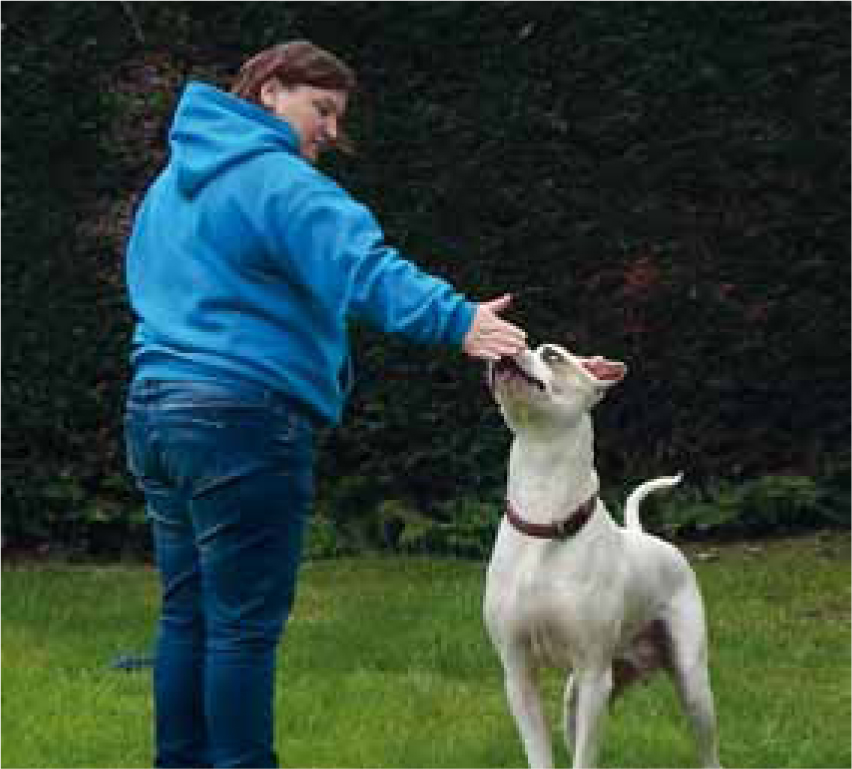
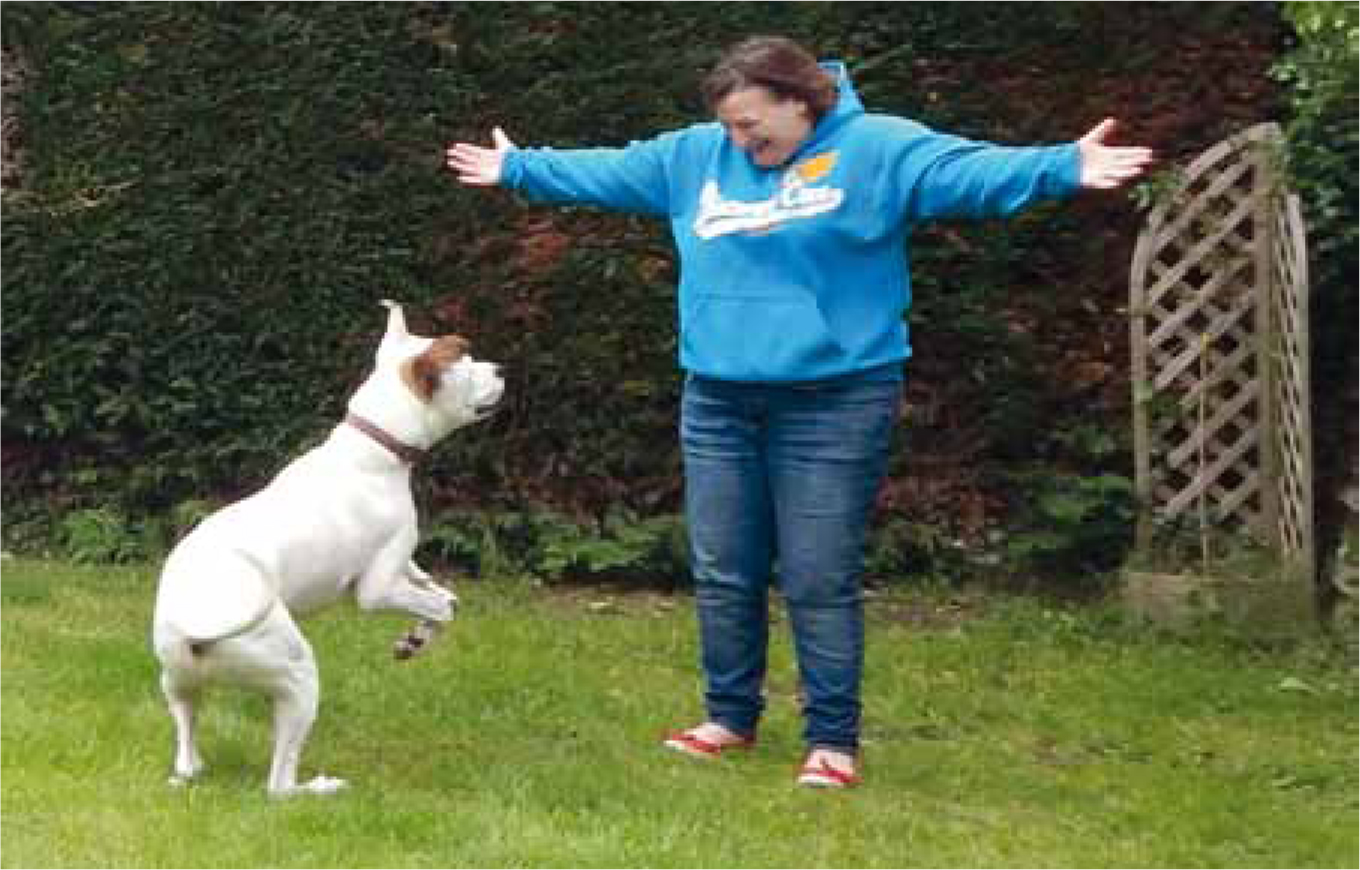
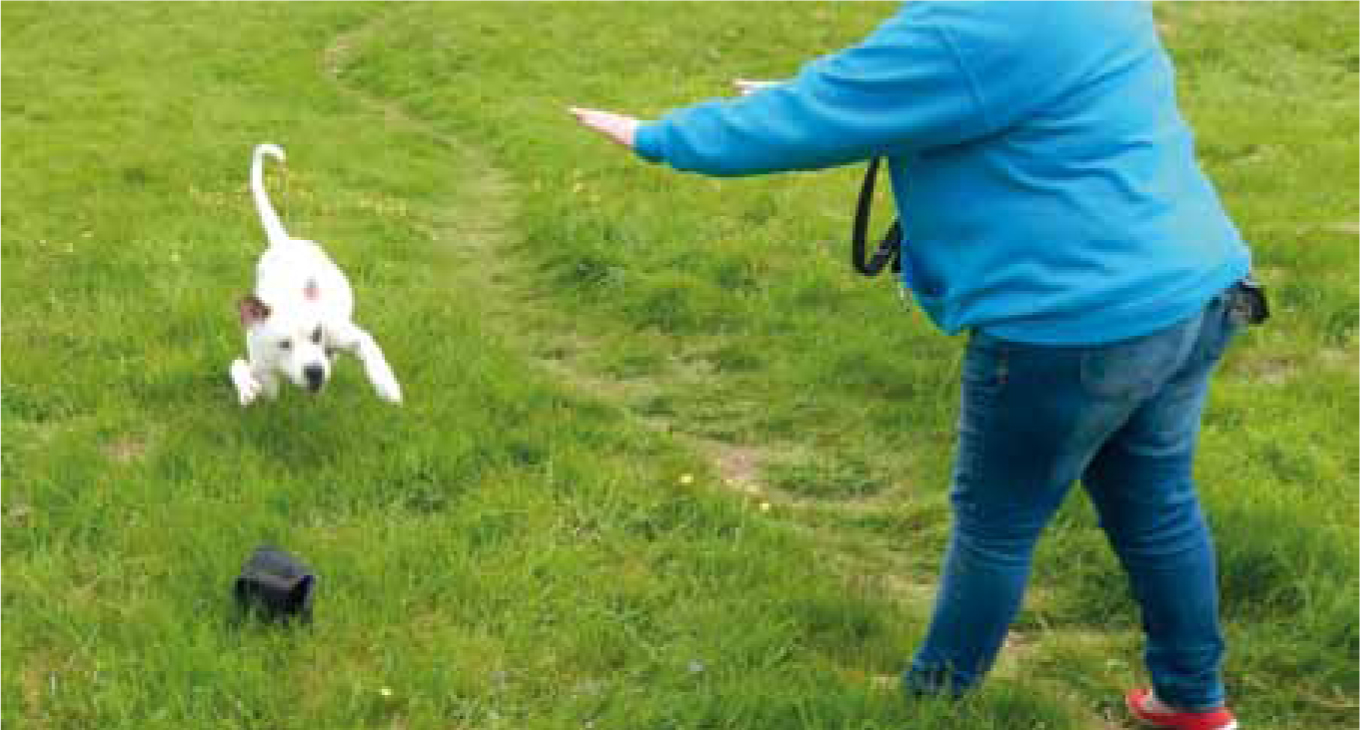
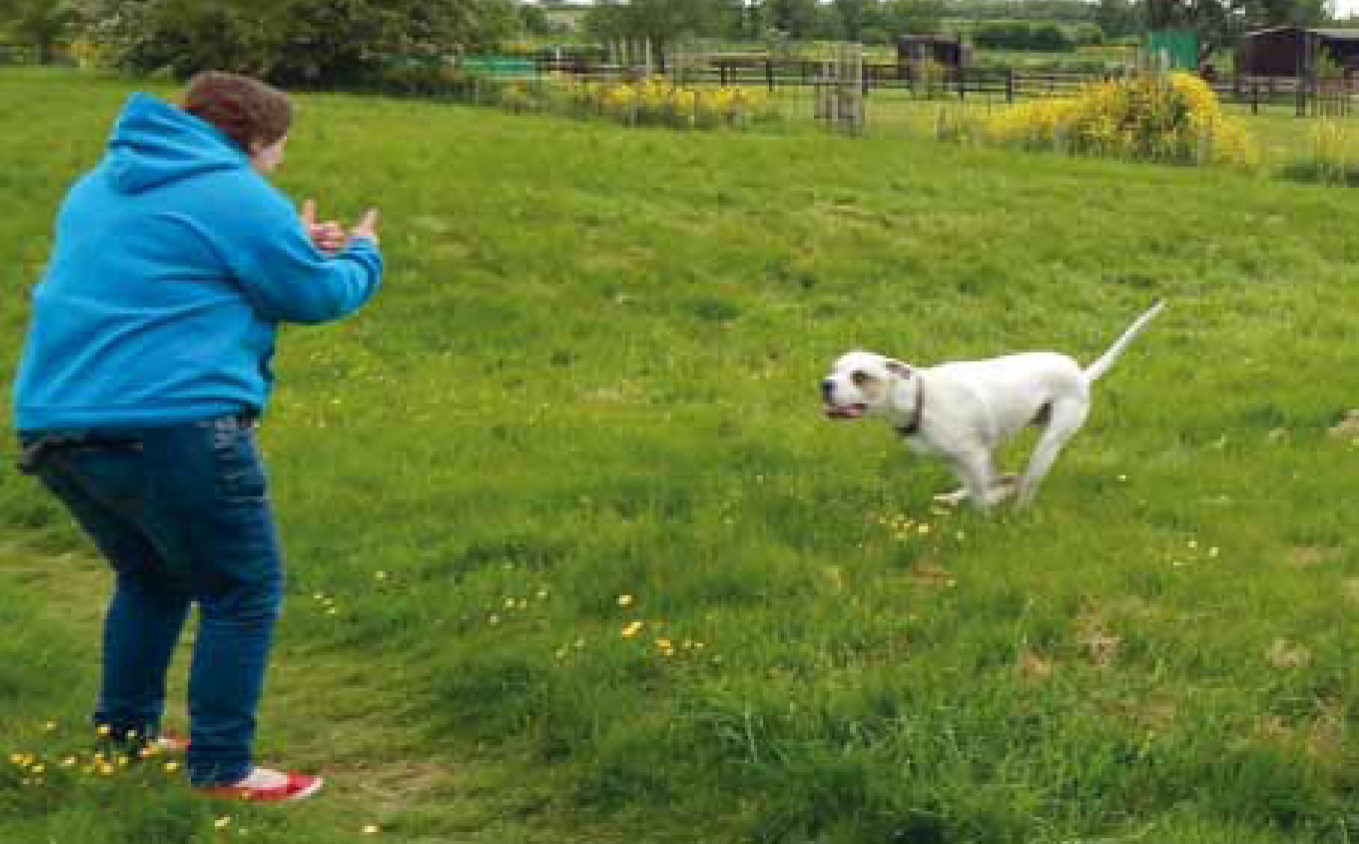
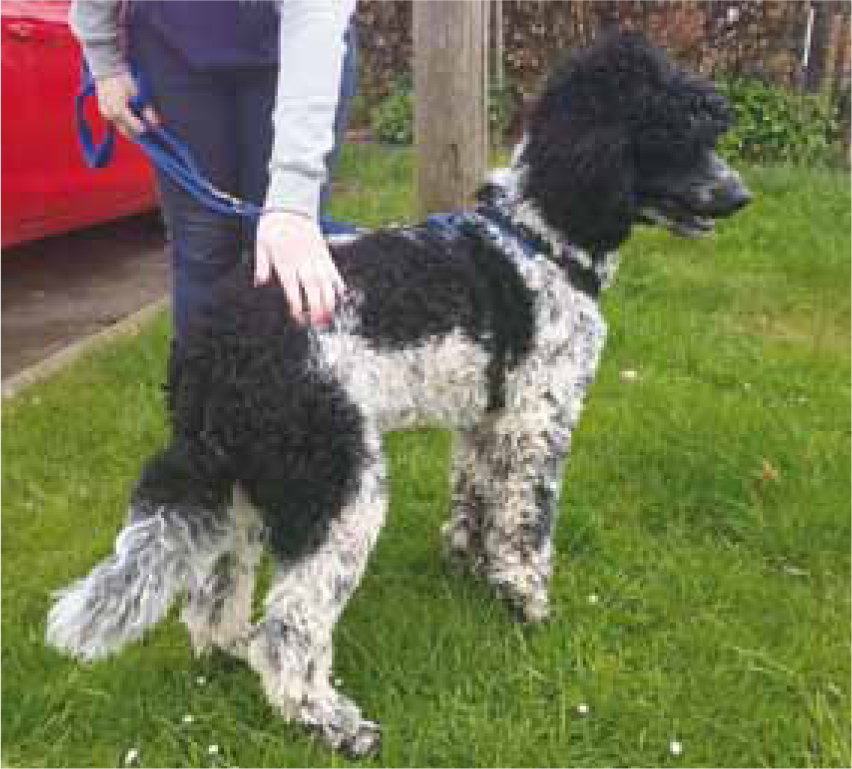
Waking the deaf dog
Dogs (and people) are constantly evaluating noises from the environment and using this information to predict what is likely to happen next, even when resting (Lindsay, 2000). A hearing dog will usually have already sensed the approach of a person from footsteps, breathing or doors opening and closing long before the person reaches out to touch them. However, a deaf dog may be taken by surprise and so newly deaf dogs, those sensitive to touch or generally nervous dogs, may be startled if woken by being handled. Waking the dog by positioning yourself in the dog's line of sight and placing a smelly food treat close to the nose can prevent this. Over time the dog can also be taught to expect touch on certain parts of the body to be followed with treats, reducing worry or defensive reflex responses when this happens. The client should practice on parts of the body that will be accessible most the time, e.g. the top of the head, shoulder blades, dorsal thorax or flanks. An example of the steps typically used in this training is given in Box 1, although this varies from dog to dog. Visitors should be asked not to touch the dog when asleep until they have been introduced and the dog is familiar with their smell. They should then use the same protocol.
Supporting dogs with sight loss
Safety
As discussed above, loss of any sense reduces input of environmental information and so immediately places the dog at increased risk. Most dogs are able to learn to navigate a consistent environment. Keeping furniture and obstacles in the same place and avoiding clutter on floors can therefore help to prevent impact or accidents which may undermine confidence and so inhibit future movement. Ways the dog's ability to navigate can be enhanced through sound, smell and texture are summarised in Table 3. Table legs, cupboards or other potential hazards can be padded with bubble wrap, pipe insulation or baby proofing products while the dog is adjusting. Barriers should be erected around potential hazards such as ponds and pools, and dog gates can be used across doorways to areas that are not dog proofed and at the top and bottom of staircases. Blind dogs will often learn to cope with walking upstairs under supervision, but may initially be reluctant to walk down them, especially small dogs that require a leap of faith if they cannot see where they will land. Short runs of steps, such as access into a garden, can be modified with a ramp enabling the dog to get up and down unaided. Plants, barriers or other objects can be used to prevent access to steps not covered by the ramp or to prevent the dog from straying off the sides (Figure 6). Dogs that sleep on elevated surfaces such as beds or sofas may benefit from strategically placed steps, ramps or foot stools to enable them to make the transitions in two or three levels rather than one.
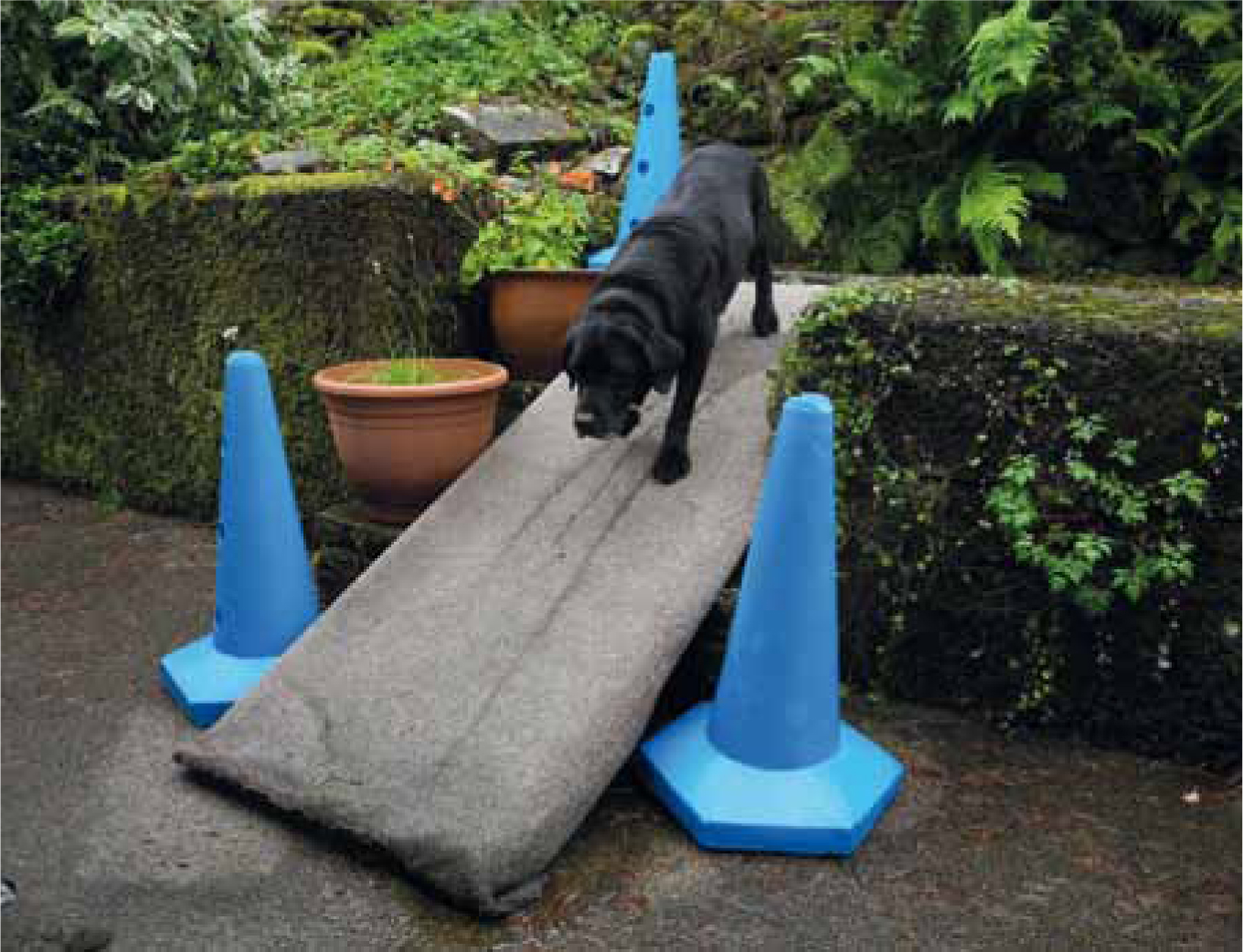
| Navigational aid | Effect |
|---|---|
| Scents | Applying and regularly replenishing scents to surfaces such as table legs and doorways enables the dog to use smell for navigation. Everyday scents such as polish, surface fresheners or non-toxic essential oils can be useful. Proprietary scented discs, e.g. Tracerz® (Innovet Pet Products) may be more reliable and convenient. Scents should be positioned at the dog's head height. Where they cannot be applied directly to the surface a cloth impregnated with the scent can be attached to the obstacle. |
| Radio | Leaving a radio or other clearly identifiable sound permanently on in the room in which the dog sleeps can orientate them on waking. |
| Bells and chimes | Attaching small bells to major obstacles such as furniture can enable identification and warn the dog before impact. Bells attached to other household members, such as conspecifics and other pets, can help the dog monitor their whereabouts. Wind chimes by external doors indicate to the dog when they are open. |
| Surfaces | Mats or runners can be used to mark key locations such as pathways, routes across a room and feeding stations. |
| Soft obstacles | Artificial or real plants can provide a soft signal the dog is approaching an obstacle, e.g. a table, tree or gate. |
| Halo | Adapted cable ties or proprietary ‘halo’ harnesses (Halos for Paws) (Figure 7) enable the dog to feel obstacles before contact. However some dogs may find them initially worrying, which may inhibit movement. |
| Sonar devices | A device that uses sonar for echo location for dogs (and horses) has recently become available in the US. However efficacy and potential inhibitory effects have not been evaluated by the author. The potential for some dogs to find sonar distressing must be considered before use. |
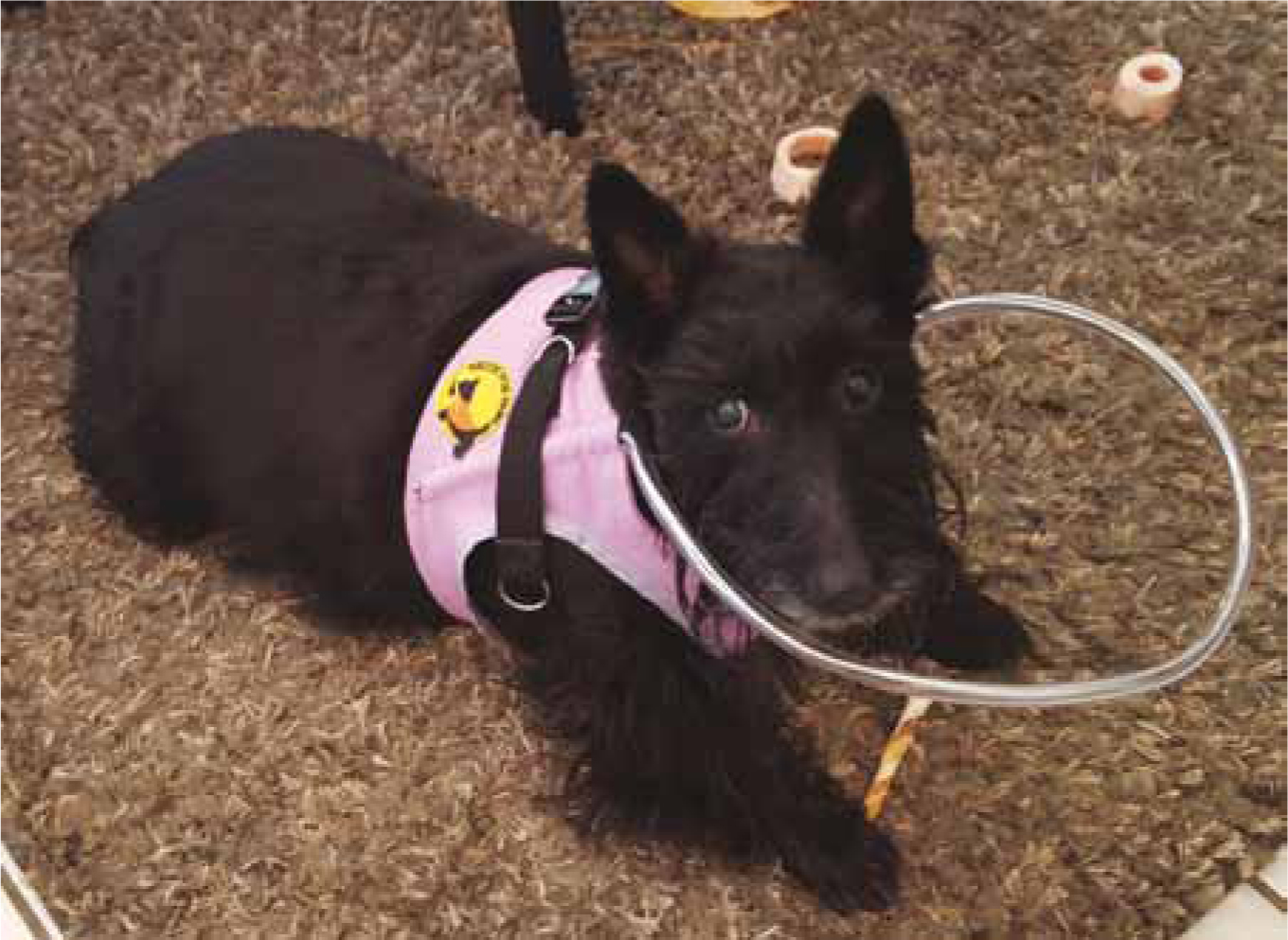
Avoid picking up blind dogs where possible. Allowing them to navigate consistent and hazard free areas builds confidence. It also enables them to maintain their bearings. If lifting is essential always set them down in the same place, such as their bed, so they know where they are. Teaching navigation commands allows the owner to guide their dog in unfamiliar situations. Examples of verbal commands and their potential uses are summarised in Table 4.
| Command/cue | Action |
|---|---|
| Touch | To warn the dog he is about to be touched or handled. This is particularly useful for dogs that were already fearful when being handled. Specific body parts can also be taught, e.g. ear, paw, tail |
| Target | Teaching the dog to touch a hand or target stick enables them to be led in unfamiliar settings |
| Lift | To warn the dog he is going to be lifted up |
| Left | To command the dog to turn left to avoid walking into an obstacle |
| Right | To command the dog to turn right to avoid walking into an obstacle |
| Stop | To command the dog to stop to prevent walking into an obstacle |
| Recall | Using a non-verbal command for recall, such as a whistle, may improve the dog's ability to discriminate and locate the command in a busy environment |
Exercise and interaction
Blind dogs still need exercise. However some may find walking in unfamiliar places worrying. The use of a hand target, target stick or the commands discussed above to guide the dog in new places will help boost confidence. Alternatively the dog can be transported to a familiar obstacle free exercise area by car, in the owner's arms or using a dog buggy. Whether the dog can be allowed off lead in an enclosed hazard free area depends, as with all dogs, on the reliability of their recall. Long leads can help where recall is not completely reliable or during training. Direct ongoing supervision is essential throughout exercise to ensure the dog avoids unexpected hazards such as low hanging branches or newly dug burrows.
Great care should be taken when allowing interaction with other dogs as the blind dog will not be able to read visual signals and so may not realise if the other dog is being threatening. Only allow interaction with dogs known to be consistently friendly and use commands to intervene or control the interaction if needed.
Blind dogs can still enjoy games, modified to their needs. Tug and other contact games can be continued and interactive ball and retrieve games can be maintained by adding a sound or smell dimension to the toy so the blind dog can locate it. Playing in a familiar, enclosed, hazard free space will boost confidence and prevent accidents. Weighted treat balls in a small empty room or high sided paddling pool can be fun for the dog, and dogs with a strong scent drive can enjoy games that involve finding or following scents such as scatter feeding, seeking games or formal tracking sports.
Supporting therapies
Some dogs may undergo a period of reduced confidence or inhibition of normal curiosity and so activity while they adjust to their sensory loss. This is particularly likely where the dog was already prone to anxiety or fear before this occurred.
Anxiety often occurs when an animal feels unable to control or avoid threats from environmental hazards or conflict with others, or feels unable to prevent the loss of something of value to them (Lindsay, 2005). This perception can be triggered by sensory loss and is often aggravated by changes to routines or how they are handled, making their environment or those around them seem unpredictable. We therefore should not under estimate the value of maintaining daily routines as much as possible. Continuing to feed, walk, play with and handle the dog in the same way and at the same times helps reassure them that although their way of sensing and interacting with their world may have changed the world itself has not.
Creating a space that the dog learns is safe and is always available can boost confidence and encourage re-exploration of the world, reassured by the knowledge that a refuge is available (Lindsay, 2005). Where the dog already had a preferred bed this can be adopted as the refuge. Alternatively a new one can be created. The refuge should be kept in the same place, be accessible at all times and should be cave like in construction, i.e. covered on all but one side and cosy without being excessively confined. The dog should never be locked in the refuge and it should not be associated with corrections. The dog should not be prevented from using it but if they become reluctant to leave it even after a few days they may need help from a Clinical Animal Behaviourist.
Appeasing pheromones in the form of Adaptil® can comfort and calm worried dogs (Tod et al, 2005). It may therefore help ease the period of adjustment during sensory loss. A diffuser located close to the refuge will enhance its perception as a place of safety. A collar ensures the pheromone stays with the dog wherever he or she goes.
In some cases pharmacological support may be needed (Landsberg et al, 2012). This is usually considered where the dog's level of anxiety is interfering with their willingness to explore or ability to adjust to their environment. Short-acting anxiolytic medication such as benzodiazepines may ease immediate anxiety but cannot be used long term due to their potential for tolerance and addiction. They also interfere with memory formation and so may hinder the learning required to adapt (Crowell-Davies and Landsberg, 2009). Medications that increase serotonin levels by blocking reuptake (tricyclic antidepressants (TCAs), selective serotonin reuptake inhibitors (SSRIs)) can be used longer term and enhance a sense of wellbeing (Landsberg et al, 2012). Medications that increase dopamine by blocking oxidation (monoamine oxidase inhibitor (MAOIs)) enhance curiosity and increase the sensation of reward (Landsberg et al, 2012). These can support the period of adjustment depending on the specific problem behaviour being seen.
Referral
Where a client requires additional support or more hands on practical help than the practice is able to offer, referral to an outside specialist may be needed (RCVS, 2016). There is currently no statuary regulation of the training and behaviour industry, or the numerous representative bodies associated with it. Veterinary professionals therefore need to take great care when choosing who to make referrals to (BSAVA, 2016). This both protects their clients and patients and ensures they fulfil their professional obligations (RCVS, 2016). The Animal Behaviour and Training Council (ABTC) has been established to provide a central point for finding qualified, accredited and accountable Animal Training Instructors and Clinical Animal Behaviourists, and is supported by the British Small Animal Veterinary Association (BSAVA) and the British Veterinary Nursing Association (BVNA).
Conclusion
Sensory loss need not be a barrier to a good quality of life. Both pet and owner need support and guidance while adjusting to the change. However the practice team is in a very good position to offer this, alongside a continually expanding range of practical and inspirational resources.
Key Points
Additional resources
Conflict of interest: none.

